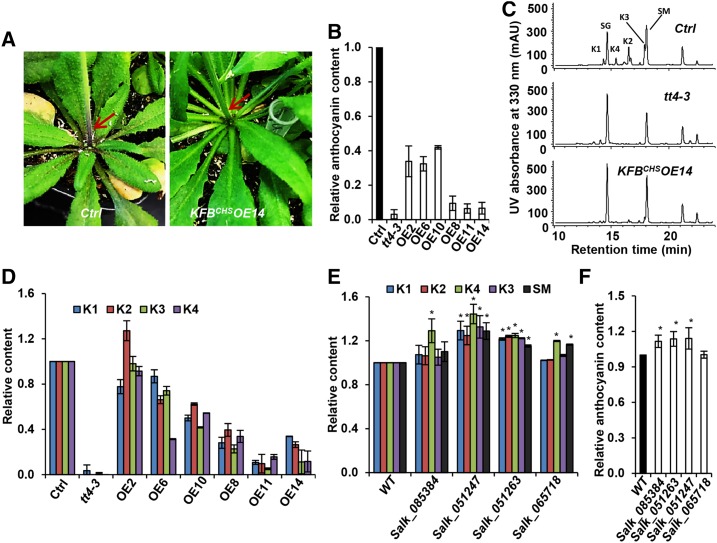Figure 4.
Overexpression of KFBCHS in Arabidopsis Impairs Flavonoid Production.
Both 6-week-old-plants and 5-DAG seedlings were grown under white light with a fluence rate of 104 ± 5 µmol·m−2·s−1 and a 16-h-light/8-h-night regime at 22°C.
(A) Visible pigmentation at the basal stem and petioles of rosette leaves of the control and KFBCHS overexpression line #14. Note the reduction of pigmentation in the overexpression line (indicated with arrow).
(B) The relative accumulation levels of anthocyanin in the 6-week-old rosette leaves of KFBCHS OE lines. The content in the control line (50 µg/g FW cyanidin 3-O-glucoside) was set as “1.” Data represents mean ± sd from three biological repeats; each repeat represents the mixed rosette leaves from nine individual plants.
(C) Representative UV-HPLC profiles of methanolic soluble phenolics in KFBCHS OE14 and tt4-3 mutant lines. K1, Kaempferol 3-O-[6′′-O-(rhamnosyl)glucoside] 7-O-rhamnoside; K2, kaempferol 3-O-glucoside 7-O-rhamnoside; K3, kaempferol 3-O-rhamnoside 7-O-rhamnoside; K4, kaempferol 3-O-rhamnoside 7-O-glucoside. Metabolites were extracted from 0.1 g FW of 5-DAG seedlings with 1 mL of 80% methanol, and 10-μL samples of each extract were injected for HPLC profiling.
(D) Relative content of soluble phenolics in the 5-DAG seedlings of KFBCHS OE lines. Peak areas for each identified compound from the control lines were set as “1.” Data represent means ± sd from three biological replicates; each repeat represents the mixed 0.1 g FW seedlings from one agar plate. For clarity, the statistical indicators were not shown.
(E) Relative content of flavonoids and sinapoyl esters accumulated in the flowers and buds of 6-week-old kfbCHS mutant lines. Metabolites were extracted from 0.1 g FW of flower and buds tissue with 1 mL of 80% methanol, and 10-μL extracts were injected for HPLC profiling. Peak areas for each identified compound from the wild type were set as “1.” Data represent means ± sd of three biological replicates. The mixed materials from three individual plants were defined as a replicate. K1, K2, K3, and K4 are same as in (C). SM, sinapoyl malate. *P < 0.05 (Student’s t test) compared with the corresponding compound in the wild type.
(F) Relative content of anthocyanin in the flowers and buds of 6-week-old kfbCHS mutant lines. Absorbance of A530 to A700 from the wild-type extract was set as “1.” Data represent means ± sd of three biological replicates as the defined in (E). *P < 0.05 (Student’s t test) compared with the wild type.

